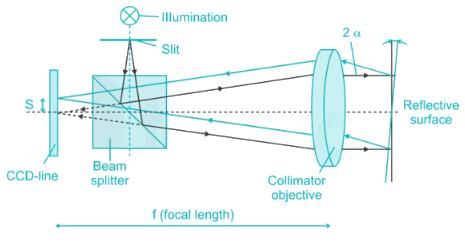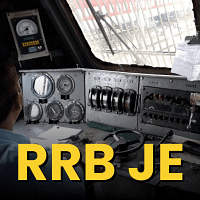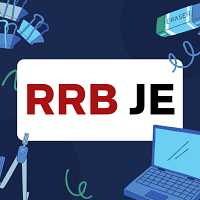Railways Exam > Railways Questions > The reflector combined with autocollimator ca...
Start Learning for Free
The reflector combined with autocollimator can be used for checking
- a)Alignment
- b)Parallelism
- c)Circularity
- d)Distance between two far off points
Correct answer is option 'A'. Can you explain this answer?
| FREE This question is part of | Download PDF Attempt this Test |
Verified Answer
The reflector combined with autocollimator can be used for checkinga)A...
Auto-Collimator is an instrument used to measure small angular inclinations. It is also used to check straightness, flatness and alignment.
A collimator is a tube for projecting parallel rays of light. It consists simply of a light source and a collimating lens (converging lens).
The principle of working of this instrument is the basic principle of reflection of light.


- Let a point source of light be placed at the principle focus of a converging lens; After passing through the lens, the beam of light becomes parallel
- If this beam of light strikes a flat reflecting surface which is perpendicular to the optical axis, it will be reflected back along its original path and refocused at the same point
- Now is the mirror is tilted by an angle θ the beam of light will be reflected back but deflected through an angle 2θ and will be focused in the same plane as the light source but displaced to one side of it
The displacement will be, d = 2fθ where f is the focal length of the lens.
Most Upvoted Answer
The reflector combined with autocollimator can be used for checkinga)A...
Reflector combined with autocollimator for checking alignment
The reflector combined with an autocollimator is commonly used in various industries, including railways, for checking alignment. This combination of instruments allows for precise measurement and verification of the alignment of different components or structures. Here's an explanation of how the reflector combined with an autocollimator can be used for checking alignment:
Alignment:
Alignment refers to the proper positioning and orientation of various components or structures. It is crucial to ensure that different parts are aligned correctly to avoid any issues or problems. The reflector combined with an autocollimator can be utilized to check the alignment by measuring the angular deviation between a reference line and the line of sight.
Working Principle:
The reflector combined with an autocollimator works based on the principle of reflection and measurement of angular deviation. Here's a step-by-step explanation of how it can be used for checking alignment:
1. Set up the reflector: The reflector is positioned at a specific location or reference point. It acts as a target for the autocollimator.
2. Position the autocollimator: The autocollimator is placed at a suitable distance from the reflector, ensuring a clear line of sight.
3. Measure the angular deviation: The autocollimator emits a collimated light beam towards the reflector. The reflector reflects the light beam back to the autocollimator.
4. Observe the autocollimator: The autocollimator has a reticle or scale that allows the user to measure the angular deviation between the emitted and reflected light beams. This angular deviation indicates the misalignment, if any.
5. Adjust the alignment: Based on the measured angular deviation, adjustments can be made to align the components or structures properly. This may involve moving or rotating the target until the desired alignment is achieved.
Benefits of using reflector combined with autocollimator:
- Precise measurement: The combination of reflector and autocollimator enables accurate measurement of angular deviations, providing valuable information about the alignment.
- Time-saving: The reflector combined with an autocollimator allows for quick and efficient alignment checking, reducing downtime and increasing productivity.
- Non-contact measurement: The measurement process is non-contact, eliminating the risk of damage to the instruments or the components being aligned.
- Versatility: The reflector combined with an autocollimator can be used for various alignment tasks in different industries, including railways.
In conclusion, the reflector combined with an autocollimator is an effective tool for checking alignment. It provides accurate measurements of angular deviations, allowing for precise alignment adjustments to be made. This combination is widely used in the railway industry and other sectors to ensure proper alignment of components and structures.
The reflector combined with an autocollimator is commonly used in various industries, including railways, for checking alignment. This combination of instruments allows for precise measurement and verification of the alignment of different components or structures. Here's an explanation of how the reflector combined with an autocollimator can be used for checking alignment:
Alignment:
Alignment refers to the proper positioning and orientation of various components or structures. It is crucial to ensure that different parts are aligned correctly to avoid any issues or problems. The reflector combined with an autocollimator can be utilized to check the alignment by measuring the angular deviation between a reference line and the line of sight.
Working Principle:
The reflector combined with an autocollimator works based on the principle of reflection and measurement of angular deviation. Here's a step-by-step explanation of how it can be used for checking alignment:
1. Set up the reflector: The reflector is positioned at a specific location or reference point. It acts as a target for the autocollimator.
2. Position the autocollimator: The autocollimator is placed at a suitable distance from the reflector, ensuring a clear line of sight.
3. Measure the angular deviation: The autocollimator emits a collimated light beam towards the reflector. The reflector reflects the light beam back to the autocollimator.
4. Observe the autocollimator: The autocollimator has a reticle or scale that allows the user to measure the angular deviation between the emitted and reflected light beams. This angular deviation indicates the misalignment, if any.
5. Adjust the alignment: Based on the measured angular deviation, adjustments can be made to align the components or structures properly. This may involve moving or rotating the target until the desired alignment is achieved.
Benefits of using reflector combined with autocollimator:
- Precise measurement: The combination of reflector and autocollimator enables accurate measurement of angular deviations, providing valuable information about the alignment.
- Time-saving: The reflector combined with an autocollimator allows for quick and efficient alignment checking, reducing downtime and increasing productivity.
- Non-contact measurement: The measurement process is non-contact, eliminating the risk of damage to the instruments or the components being aligned.
- Versatility: The reflector combined with an autocollimator can be used for various alignment tasks in different industries, including railways.
In conclusion, the reflector combined with an autocollimator is an effective tool for checking alignment. It provides accurate measurements of angular deviations, allowing for precise alignment adjustments to be made. This combination is widely used in the railway industry and other sectors to ensure proper alignment of components and structures.
Attention Railways Students!
To make sure you are not studying endlessly, EduRev has designed Railways study material, with Structured Courses, Videos, & Test Series. Plus get personalized analysis, doubt solving and improvement plans to achieve a great score in Railways.

|
Explore Courses for Railways exam
|

|
Similar Railways Doubts
The reflector combined with autocollimator can be used for checkinga)Alignmentb)Parallelismc)Circularityd)Distance between two far off pointsCorrect answer is option 'A'. Can you explain this answer?
Question Description
The reflector combined with autocollimator can be used for checkinga)Alignmentb)Parallelismc)Circularityd)Distance between two far off pointsCorrect answer is option 'A'. Can you explain this answer? for Railways 2024 is part of Railways preparation. The Question and answers have been prepared according to the Railways exam syllabus. Information about The reflector combined with autocollimator can be used for checkinga)Alignmentb)Parallelismc)Circularityd)Distance between two far off pointsCorrect answer is option 'A'. Can you explain this answer? covers all topics & solutions for Railways 2024 Exam. Find important definitions, questions, meanings, examples, exercises and tests below for The reflector combined with autocollimator can be used for checkinga)Alignmentb)Parallelismc)Circularityd)Distance between two far off pointsCorrect answer is option 'A'. Can you explain this answer?.
The reflector combined with autocollimator can be used for checkinga)Alignmentb)Parallelismc)Circularityd)Distance between two far off pointsCorrect answer is option 'A'. Can you explain this answer? for Railways 2024 is part of Railways preparation. The Question and answers have been prepared according to the Railways exam syllabus. Information about The reflector combined with autocollimator can be used for checkinga)Alignmentb)Parallelismc)Circularityd)Distance between two far off pointsCorrect answer is option 'A'. Can you explain this answer? covers all topics & solutions for Railways 2024 Exam. Find important definitions, questions, meanings, examples, exercises and tests below for The reflector combined with autocollimator can be used for checkinga)Alignmentb)Parallelismc)Circularityd)Distance between two far off pointsCorrect answer is option 'A'. Can you explain this answer?.
Solutions for The reflector combined with autocollimator can be used for checkinga)Alignmentb)Parallelismc)Circularityd)Distance between two far off pointsCorrect answer is option 'A'. Can you explain this answer? in English & in Hindi are available as part of our courses for Railways.
Download more important topics, notes, lectures and mock test series for Railways Exam by signing up for free.
Here you can find the meaning of The reflector combined with autocollimator can be used for checkinga)Alignmentb)Parallelismc)Circularityd)Distance between two far off pointsCorrect answer is option 'A'. Can you explain this answer? defined & explained in the simplest way possible. Besides giving the explanation of
The reflector combined with autocollimator can be used for checkinga)Alignmentb)Parallelismc)Circularityd)Distance between two far off pointsCorrect answer is option 'A'. Can you explain this answer?, a detailed solution for The reflector combined with autocollimator can be used for checkinga)Alignmentb)Parallelismc)Circularityd)Distance between two far off pointsCorrect answer is option 'A'. Can you explain this answer? has been provided alongside types of The reflector combined with autocollimator can be used for checkinga)Alignmentb)Parallelismc)Circularityd)Distance between two far off pointsCorrect answer is option 'A'. Can you explain this answer? theory, EduRev gives you an
ample number of questions to practice The reflector combined with autocollimator can be used for checkinga)Alignmentb)Parallelismc)Circularityd)Distance between two far off pointsCorrect answer is option 'A'. Can you explain this answer? tests, examples and also practice Railways tests.

|
Explore Courses for Railways exam
|

|
Suggested Free Tests
Signup for Free!
Signup to see your scores go up within 7 days! Learn & Practice with 1000+ FREE Notes, Videos & Tests.
























